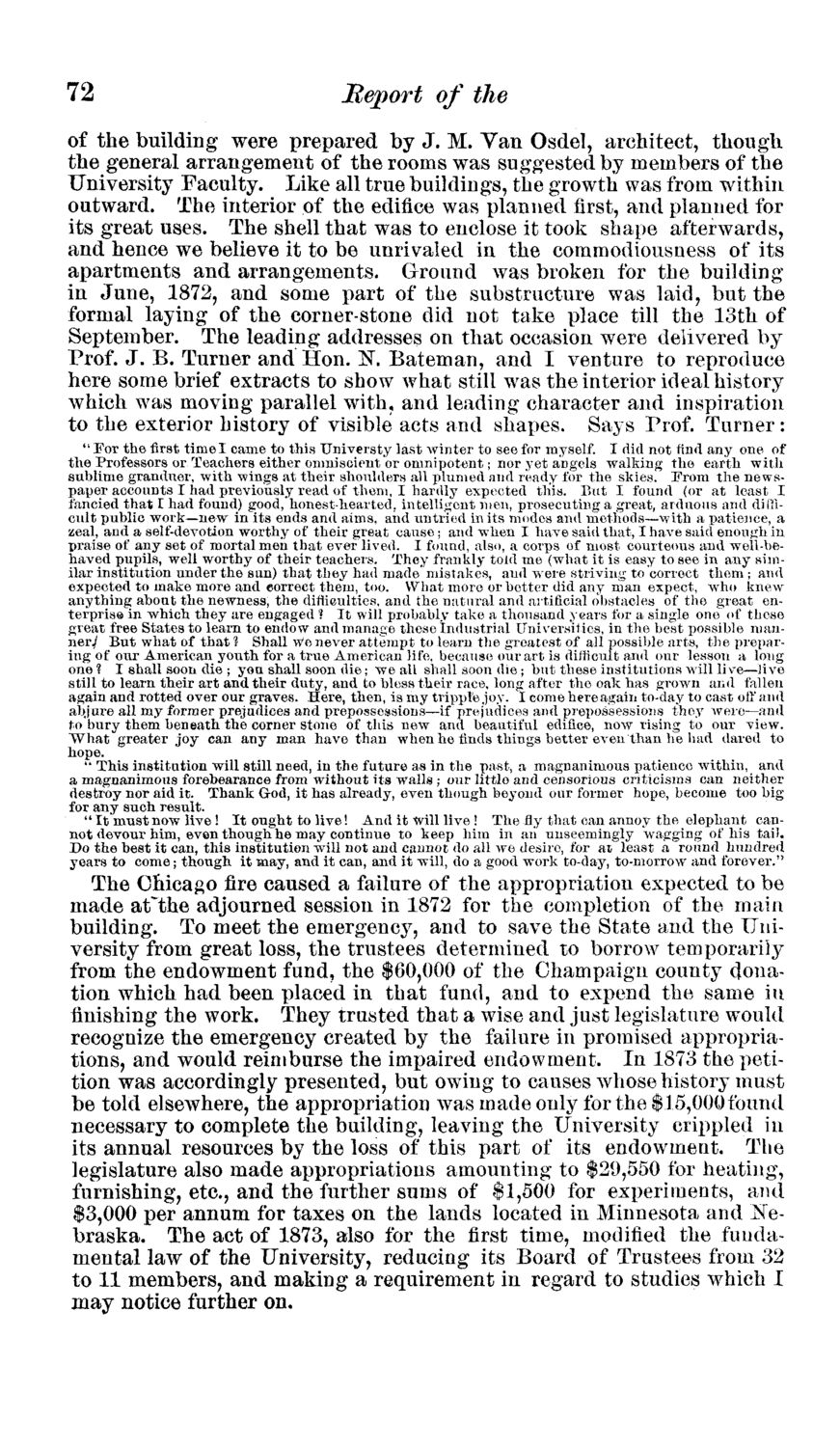| |
| |
Caption: Board of Trustees Minutes - 1874
This is a reduced-resolution page image for fast online browsing.

EXTRACTED TEXT FROM PAGE:
72 Heport of the of the building were prepared by J. M. Van Osdel, architect, though the general arrangement of the rooms was suggested by members of the University Faculty. Like all true buildings, the growth was from within outward. The interior of the edifice was planned first, and planned for its great uses. The shell that was to enclose it took shape afterwards, and hence we believe it to be unrivaled in the commodiousness of its apartments and arrangements. Ground was broken for the building in June, 1872, and some part of the substructure was laid, but the formal laying of the corner-stone did not take place till the 13th of September. The leading addresses on that occasion were delivered by Prof. J . B. Turner and Hon. K Bateman, and I venture to reproduce here some brief extracts to show what still was the interior ideal history which was moving parallel with, and leading character and inspiration to the exterior history of visible acts and shapes. Says Prof. Turner: " For the first time I came to this Universty last winter to see for myself. I did not find any one of the Professors or Teachers either omniscient or omnipotent; nor yet angels walking the earth with sublime granduer, with wings at their shoulders all plumed and ready for the skies. Prom the newspaper accounts I had previously read of them, I hardly expected this. But I found (or at least I fancied that I had found) good, honest-hearted, intelligent men, prosecuting a great, arduous and difficult public work—new in its ends and aims, and untried in its modes and methods—with a patience, a zeal, and a self-devotion worthy of their great cause; and when I have said that, I have said enough in praise of any set of mortal men that ever lived. I found, also, a corps of most courteous and well-behaved pupils, well worthy of their teachers. They frankly told me (what it is easy to see in any similar institution under the sun) that they had made' mistakes, and were striving to correct them ; and expected to make more and correct them, too. What more or better did any man expect, who knew anything about the newness, the difficulties, and the natural and artificial obstacles of the great enterprise in which they are engaged ? I t will probably take a thousand years for a single one of these great free States to learn to endow and manage these industrial Universities, in the best possible manner^ But what of that"? Shall we never attempt to learn the greatest of all possible arts, the preparing of our American youth for a true American life, because our art is difficult and our lesson a long one ? I shall soon die ; you shall soon die; we all shall soon die ; but these institutions will live—Jive still to learn their art and their duty, and to bless their race, long after the oak has grown and fallen again and rotted over our graves. Here, then, is my tripple joy. I come here again to-day to cast off and abjure all my former prejudices and prepossessions—if prejudices and prepossessions they were—and t o b u r y them beneath the corner stone of this new and. beautiful edifice, now rising to our view. What greater joy can any man have than when he finds things better even than he had dared to hope. " This institution will still need, in the future as in the past, a magnanimous patience within, and a magnanimous forebearance from without its walls ; our little and censorious criticisms can neither destroy nor aid it. Thank God, it has already, even though beyond our former hope, become too big for any such result. " I t must now live ! I t onght to live! And it Will live ! The fly that can annoy the elephant cannot devour him, even though he may continue to keep him in ail unseemingly wagging of his tail. Do the best it can, this institution will not and cannot do all we desire, for at least a round hundred years to come; though it may, and it can, and it will, tlo a good work to-day, to-morrow and forever." The Chicago fire caused a failure of the appropriation expected to be made atfthe adjourned session in 1872 for the completion of the main building. To meet the emergency, and to save the State and the University from great loss, the trustees determined to borrow temporarily from the endowment fund, the $60,000 of the Champaign county donation which had been placed in that fund, and to expend the same iu finishing the work. They trusted that a wise and just legislature would recognize the emergency created by the failure in promised appropriations, and would reimburse the impaired endowment. In 1873 the petition was accordingly presented, but owing to causes whose history must be told elsewhere, the appropriation was made only for the $15,000 found necessary to complete the building, leaving the University crippled in its annual resources by the loss of this part of its endowment. The legislature also made appropriations amounting to $29,550 for heating, furnishing, etc., and the further sums of $1,500 for experiments, and $3,000 per annum for taxes on the lands located in Minnesota and Nebraska. The act of 1873, also for the first time, modified the fundamental law of the University, reducing its Board of Trustees from 32 to 11 members, and making a requirement in regard to studies which I may notice further on.
| |